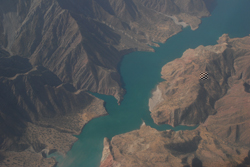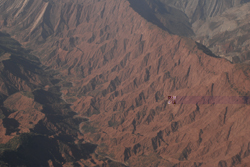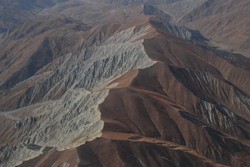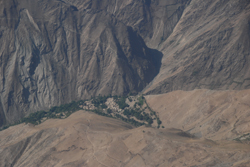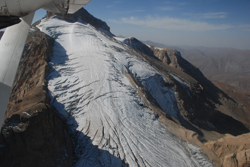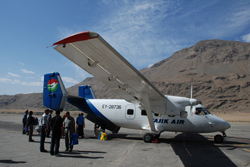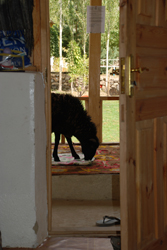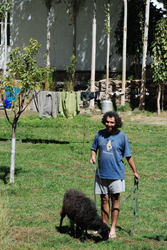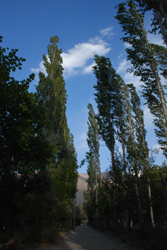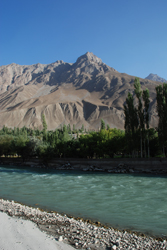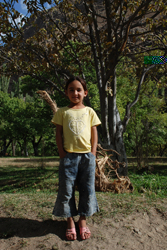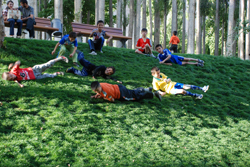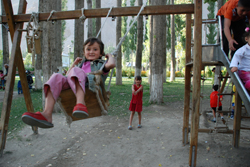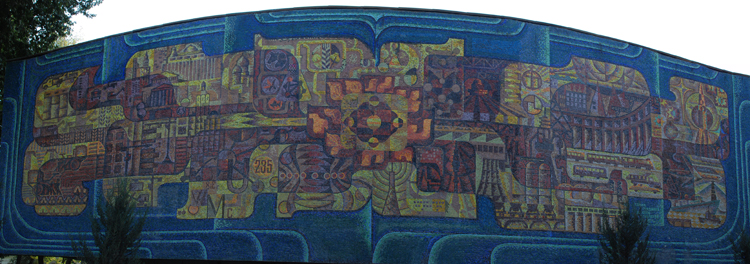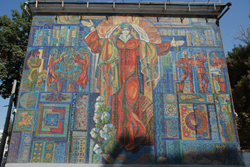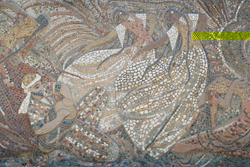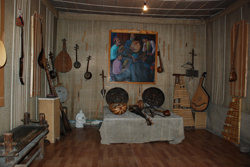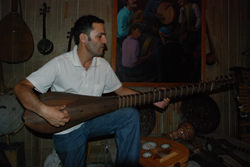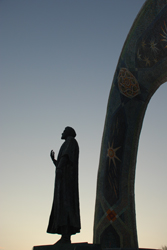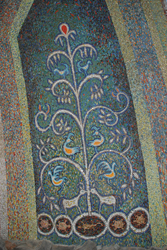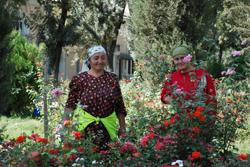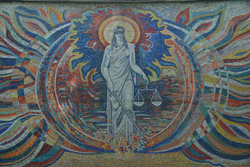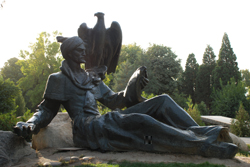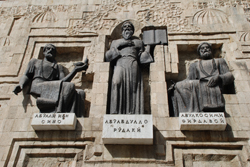Khorog: Brushing Elbows with Mountain Tops
13 September, 2008, 02:34 am in "Tajikistan"
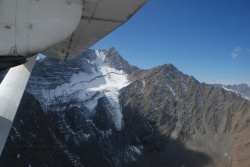 9.13.08 Khorog: Brushing Elbows with Mountain Tops
9.13.08 Khorog: Brushing Elbows with Mountain Tops At the Dushanbe airport the airline wouldn't let people board the plane until they were sure the weather was OK in Khorog. I found this reassuring. The Khorog weather checking delayed the flight for about an hour even though the weather in Dushanbe was fine. The waiting room had a lot of people but most didn't seem to have any luggage. Then I found there were also people waiting for a flight to Khojand. When they called the Khojand flight, most of the people left leaving a much smaller group—most of whom had huge bags. There is a 10K free baggage weight limit which includes carry-on.
The plane had 17 rickety seats with fold down backs. The luggage was stowed in the tail which is also where we boarded. The boarding order was, “Ladies first.” There was a bit of a problem because someone was bringing a large microwave or TV and it had been placed on 2 seats. Since the plane was full the last 2 people to board had nowhere to sit. The woman who was sitting in the seat in front said, “Put it in the aisle and just sit there!” But, it was too big to fit between the seats. Eventually someone found a place for it in the tail. One of our bags was put in front and most of the space under the seats was filled with other items. Bags were also stuck in the aisle between seats and on people's laps. The plane took off sounding like a giant fly. Seat belts were optional.
We flew over some fields and soon were above foothills. Then we began crossing the mountains. First we were flying over them. We flew above a long turquoise lake. I think it was the Nurek Dam.
We couldn't help noticing the beautiful colors and textures of the mountains below us. Some were red, some dark brown, wrinkled or rough and dry like sun-bleached leather.
Then the mountains got higher and more jagged. Instead of flying over, we were often flying between them. Far below were river valleys, some with little villages resting by the river. More outlandish, were the occasional seemingly inaccessible village we saw perched up in the mountains.
The sharp peaks of the mountains approached at eye-level. Some were adorned with glaciers. From the plane, it looked like the wings were at risk of being clipped by the rocks. Beyond the snow tipped peaks were more ranges of snow capped mountains carved against the blue sky. As we passed one beautiful peak, we'd see another approaching. Occasionally the plane hit a little turbulence or did a startling little drop, but all in all it was a very calm flight.
Rowshan, deciding he wanted to take photos from the other side of the plane got up and leaned over the man sitting across from us to take the shot. Then he sat back down, only to jump up and try to take another photo from that window. Every time he moved back and forth I could feel the plane lurch a little so I played flight attendant and told him to please stay seated.
Slowly we descended into a river valley and smoothly landed. As the pilot got off, I think I heard him make a remark, a bit irritated, about the amount of weight in the plane.
Slowly we descended into a river valley and smoothly landed. As the pilot got off, I think I heard him make a remark, a bit irritated, about the amount of weight in the plane.
We checked into the Pamir Lodge which is probably the first place we've been in Tajikistan where we felt really relaxed. The rooms were simple with futons on a raised sleeping platform. There is a big yard, water flowing through the property and mountains rising behind it. In front of the rooms is a raised patio.
When we arrived, the sun was shining just enough on our part of the patio that Rowshan could relax in it and I could sit in the shade. We ordered breakfast and then just sat and enjoyed the fresh air, peace, and feeling of being someplace that was nice enough that we didn't want to find somewhere else to be.
The lodge also has several sheep that have leashes but always manage to escape. One seemed to have a taste for tea and would wander around the patio searching for leftovers.
When we arrived, the sun was shining just enough on our part of the patio that Rowshan could relax in it and I could sit in the shade. We ordered breakfast and then just sat and enjoyed the fresh air, peace, and feeling of being someplace that was nice enough that we didn't want to find somewhere else to be.
The lodge also has several sheep that have leashes but always manage to escape. One seemed to have a taste for tea and would wander around the patio searching for leftovers.
Even though Khorog is the largest town in the Pamirs, it still is very small. A turquoise river rushing through it. There is a park on the river and hopefully one day someone will open a nice teahouse there. The main street is easy to disregard. There are some businesses, a couple restaurants, some tour agencies and several mini-markets. When we first drove down it and across the river, Rowshan asked where the center of town was, not realizing we had just driven through it. In Khorog, the best thing to do is look up at the mountains which tower above it, or admire the green trees that disappear once you get a couple km away into the hills.
We walked to the bazaar which was closing down and found a chaihane with windows overlooking the river. They were finished serving food so we just had some tea.
The kids in the town are friendly and often like to have their photos taken. In the center of town, there is a new park created by the Aga Kahn Development Network. At night it is lit up when the main streets of town are dark. During the day, everyone seems to be enjoying this pretty addition to the town.
The kids in the town are friendly and often like to have their photos taken. In the center of town, there is a new park created by the Aga Kahn Development Network. At night it is lit up when the main streets of town are dark. During the day, everyone seems to be enjoying this pretty addition to the town.
[ View 1 Comments
|
]
Art in Dushanbe
12 September, 2008, 11:19 am in "Tajikistan"
While on a bus from the airport to the center, we saw a beautiful mosaic of a woman with cotton and other scenes of agriculture and industry-- typical Soviet Union art topics, but nonetheless, a find piece of art. I really like the mosaics around Dushanbe.
The Rudaki arch is my favorite with flowers, stars, suns, and rich colors. It was by an artist named Sabzali. I believe it is the newest mosaic in town, created in 2008. It is refreshingly free of Soviet iconography. Walking towards the center we passed a group of women tending a rose garden. They were all dressed in colorful dresses, some even with floral patterns.
Next we went to the museum of National Antiquities. We sped through the stone and bronze age but paid a lot more attention to the sections on later archaeological finds around the different parts of Tajikistan. My favorite pieces were fragments of clay wall painting s from Penjikent. Their style was reminiscent of art from the Far East rather than what one thinks of as Central Asian style. One of the interesting things about traveling by land is one begins to see that there isn't a solid line drawn between cultures. Instead there is this beautiful blur. Tajikistan blurs Afghan, Persian, Islam and Buddhism... as well as perhaps some Ancient Greek. In looking at some carvings on stone in Persian, I noticed some designs reminiscent of Nepalese or Tibetan designs. There was a statue of Shiva, a Zoroastrian fire hearth, and a huge reclining Buddha a bit like one we had seen in Thailand.
The Gurminj Museum of Musical Instruments is in a house whose interior walls have been lined with burlap and decorated with lots of ropes. The collection had belonged to Gurminj Zavkybekov, a famous actor who started collecting instruments when he was 10. He was famous for the role of Rustam in Ferdozi's Shahsname.
The first room had a huge tar made by Xodan Nazar as well as Indian sitars, an Afghan rebab, and some other stringed instruments. Xodan Nazat was a famous Tajik musical instrument maker who was killed. Along the floor were some ethnographic pieces: wood vessels, clogs and ibex horns.
The 2nd room had percussion instruments, flutes and accordions. The museum did not have written information about the items. Instead, a man working there, Shambe, gave us a guided tour and told us about the instruments as well as played a couple. He was from a village in the Pamirs called Rushan, where he said numerous musicians lived. He was part of a folk group in Dushanbe but many were on vacation at the moment so they weren't performing anywhere.
The last room had stringed instruments. Shambe played a song on a kemance with metal sound box. He also showed us a large setar also built by Nazar which Zavkybekov named Ergonun. Shambe explained that in a Pamir house, there are 5 pillars representing 5 prophets. The setar had been made from the central pillar.
The Gurminj Museum of Musical Instruments is in a house whose interior walls have been lined with burlap and decorated with lots of ropes. The collection had belonged to Gurminj Zavkybekov, a famous actor who started collecting instruments when he was 10. He was famous for the role of Rustam in Ferdozi's Shahsname.
The first room had a huge tar made by Xodan Nazar as well as Indian sitars, an Afghan rebab, and some other stringed instruments. Xodan Nazat was a famous Tajik musical instrument maker who was killed. Along the floor were some ethnographic pieces: wood vessels, clogs and ibex horns.
The 2nd room had percussion instruments, flutes and accordions. The museum did not have written information about the items. Instead, a man working there, Shambe, gave us a guided tour and told us about the instruments as well as played a couple. He was from a village in the Pamirs called Rushan, where he said numerous musicians lived. He was part of a folk group in Dushanbe but many were on vacation at the moment so they weren't performing anywhere.
The last room had stringed instruments. Shambe played a song on a kemance with metal sound box. He also showed us a large setar also built by Nazar which Zavkybekov named Ergonun. Shambe explained that in a Pamir house, there are 5 pillars representing 5 prophets. The setar had been made from the central pillar.
Across from the museum was another mosaic decorating the district court. Since we were on the subject of mosaics, I suggested walking up Rudaki and finding another mosaic. The subject of this one was agriculture and industry. It was created with lots of oranges and golds but a bit more abstract than the cotton one. It was near the Pedagogical University. On the way there we stopped by the Omar Khayam statue near a hotel. Persian culture is also celebrated on the wall of the Writer's Union building where several Persian authors are represented.
Dushanbe: Searching for the Turkmenistan Embassy
10 September, 2008, 11:19 am in "Tajikistan"
9.10.08 Dushanbe: Searching for the Turkmenistan Embassy
Our business of the day was getting a Turkmenistan transit visa.
We headed past the market to the location shown in Lonely Planet only to find a sign on the door that said, “The Turkmenistan Embassy is at a different address.” It didn't say where. We asked a man across the street who said if we walked down the street past Ayni, and turned left, we'd find the embassy. We followed his directions and found the Azerbaijan Embassy. Someone then said the Turkmenistan consulate was now way up on Rudaki near the Agricultural University.
We decided to check the Internet to see if we could find the actual address. On a couple sites it was listed-- 105 Rudaki. We took the bus but since it is often hard to see street numbers we overshot 105. Walking back we found 105 was a hotel. Thinking perhaps either I or the web sites had been dyslexic I said, “Maybe it was 150.” So we got back on the bus and headed towards 150. We saw the Agricultural University but overshot it hoping that we'd see a Turkmen flag. When we didn't, we walked back asking. Someone said 150 was near the square so we headed past the university but still didn't find it. A man pointed up a narrow street saying it was past the Pakistan Embassy. We walked up the street but saw neither Pakistan or Turkmenistan embassy. No one we asked knew anything about either embassy, so we went back to the main street and asked a guard at a school. He said it was off the street that ran west from the square. Another guard said it was south. Then there was some confusion about if the one in the south was Uzbekistan. They went to ask someone else who said something different. We walked south and asked a taxi driver. He said, “It's just 50 meters south of here.” We hurriedly walked 50 meters and came to the Chinese consulate. Rowshan asked there and a guard said it was up the street left of the main square. Rowshan was dubious. We had decided people here give you directions even if they have no idea where the place is. A woman waiting assured us it really was there. We walked back to the square, turned left and walked a block. Rowshan noticed a flag, so we turned right on the next street, left into an alley and finally found the Turkmenistan Embassy. The guard called the consul and said he'd see us and we could take a seat. There were 2 plastic chairs in the alley and a bench occupied by an old man. We sat down and the old man began to question Rowshan with all the standard questions: Where are you from? Are you a Muslim? Are you married? Do you have any children? Why not? Then added some more. He asked how much a plane ticket form the US to Istanbul was. Rowshan said probably around $1000. “No! You are wrong!” the man responded. “I know people who paid $11,000.”
Rowshan shrugged, knowing it wasn't worth arguing, “Yah, you are right.” The guard laughed. The man asked what Rowshan's job was several times and then, “If you are traveling, you must have $100,000 on you.” “No,” Rowshan said, “I have 1 million.” The man said, “There are lots of millionaires in America.” Rowshan replied, “I'm one of them.” He asked Rowshan why he had long hair and Rowshan responded he didn't have time to cut it. The man offered to cut it right there and then and told the guard to bring scissors. The man asked where Rowshan's parents lived and how old he was. Rowshan replied then asked him how old he was and he said, “82”. Rowshan said, “Mashalah, God willing, I'll reach 82” and both the guard and old man said “Amin” bringing their hands down in front of their faces in a common Central Asian gesture. It turned out the man was Uzbek but he'd moved to Tajikistan when he was 12. Eventually a woman left the consulate and the consul appeared at the door calling us in. He was friendly and helpful. We filled out the application and he said to come back in a couple weeks. It was very easy but I joked we'd Rowshan had already been screened by the old man at the door who perhaps was a secret screener for Turkmenistan.
Our business of the day was getting a Turkmenistan transit visa.
We headed past the market to the location shown in Lonely Planet only to find a sign on the door that said, “The Turkmenistan Embassy is at a different address.” It didn't say where. We asked a man across the street who said if we walked down the street past Ayni, and turned left, we'd find the embassy. We followed his directions and found the Azerbaijan Embassy. Someone then said the Turkmenistan consulate was now way up on Rudaki near the Agricultural University.
We decided to check the Internet to see if we could find the actual address. On a couple sites it was listed-- 105 Rudaki. We took the bus but since it is often hard to see street numbers we overshot 105. Walking back we found 105 was a hotel. Thinking perhaps either I or the web sites had been dyslexic I said, “Maybe it was 150.” So we got back on the bus and headed towards 150. We saw the Agricultural University but overshot it hoping that we'd see a Turkmen flag. When we didn't, we walked back asking. Someone said 150 was near the square so we headed past the university but still didn't find it. A man pointed up a narrow street saying it was past the Pakistan Embassy. We walked up the street but saw neither Pakistan or Turkmenistan embassy. No one we asked knew anything about either embassy, so we went back to the main street and asked a guard at a school. He said it was off the street that ran west from the square. Another guard said it was south. Then there was some confusion about if the one in the south was Uzbekistan. They went to ask someone else who said something different. We walked south and asked a taxi driver. He said, “It's just 50 meters south of here.” We hurriedly walked 50 meters and came to the Chinese consulate. Rowshan asked there and a guard said it was up the street left of the main square. Rowshan was dubious. We had decided people here give you directions even if they have no idea where the place is. A woman waiting assured us it really was there. We walked back to the square, turned left and walked a block. Rowshan noticed a flag, so we turned right on the next street, left into an alley and finally found the Turkmenistan Embassy. The guard called the consul and said he'd see us and we could take a seat. There were 2 plastic chairs in the alley and a bench occupied by an old man. We sat down and the old man began to question Rowshan with all the standard questions: Where are you from? Are you a Muslim? Are you married? Do you have any children? Why not? Then added some more. He asked how much a plane ticket form the US to Istanbul was. Rowshan said probably around $1000. “No! You are wrong!” the man responded. “I know people who paid $11,000.”
Rowshan shrugged, knowing it wasn't worth arguing, “Yah, you are right.” The guard laughed. The man asked what Rowshan's job was several times and then, “If you are traveling, you must have $100,000 on you.” “No,” Rowshan said, “I have 1 million.” The man said, “There are lots of millionaires in America.” Rowshan replied, “I'm one of them.” He asked Rowshan why he had long hair and Rowshan responded he didn't have time to cut it. The man offered to cut it right there and then and told the guard to bring scissors. The man asked where Rowshan's parents lived and how old he was. Rowshan replied then asked him how old he was and he said, “82”. Rowshan said, “Mashalah, God willing, I'll reach 82” and both the guard and old man said “Amin” bringing their hands down in front of their faces in a common Central Asian gesture. It turned out the man was Uzbek but he'd moved to Tajikistan when he was 12. Eventually a woman left the consulate and the consul appeared at the door calling us in. He was friendly and helpful. We filled out the application and he said to come back in a couple weeks. It was very easy but I joked we'd Rowshan had already been screened by the old man at the door who perhaps was a secret screener for Turkmenistan.


